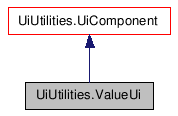UiUtilities.ValueUi Class Reference
Detailed Description
Create a row of value fields.
A label is optional, as well as increase/decrease spin buttons following each field. UI will end up looking something like the following:
+------------+ +---+---+ +------------+ +---+---+ Label | Field | | < | > | | Field | | < | > | +------------+ +---+---+ +------------+ +---+---+
You can create 1, 2, 3, or 4 fields.

Public Member Functions |
|
| __init__ () | |
| value - Tuple containing initial value for
fields. |
|
| doLayout () | |
| GetField () | |
| GetSpinButton () | |
| doCallback_ () | |
| Note this is named differently from the
parent class'
doCallback() method because the signature is different.
|
|
| numberOfFields () | |
| numberOfControls () | |
| onKillFocus () | |
| onFieldChange () | |
| onButtonPress () | |
| onButtonRelease () | |
| enable () | |
| isEnabled () | |
| Derived classes should override this.
|
|
| show () | |
| isVisible () | |
| Show () | |
| setValue () | |
| value () | |
| setValues () | |
| values () | |
| setLabel () | |
| label () | |
| setChangeCallback () | |
Member Function Documentation
| UiUtilities.ValueUi.__init__ | ( | ) |
value - Tuple containing initial value for fields.
min/max - Tuples containing ranges for fields. A value of None indicates the field value is unconstrained.
stepSizes - Tuples containing the step sizes for incrementing with the spin buttons. If you specify step sizes at all, you must specify a tuple of 3 values for each field; as you hold down on a spin button it first increments by the small step, then by the medium, then by the large.
label - Label string or None if no label to be shown.
numDecimalPlaces - Precision of the field values. For example, if the range is 0 to 10 a value of 2 will give you a precision of 0.01, ie values will be 0.00 to 10.00.
labelSize - Tuple containing width and height of label.
fieldSize - Tuple containing width and height of field.
showButtons - True if you want increment buttons shown beside each field.
Reimplemented from UiUtilities.UiComponent.
| UiUtilities.ValueUi.doLayout | ( | ) |
| UiUtilities.ValueUi.GetField | ( | ) |
| UiUtilities.ValueUi.GetSpinButton | ( | ) |
| UiUtilities.ValueUi.doCallback_ | ( | ) |
Note this is named differently from the parent class' doCallback() method because the signature is different.
| UiUtilities.ValueUi.numberOfFields | ( | ) |
| UiUtilities.ValueUi.numberOfControls | ( | ) |
| UiUtilities.ValueUi.onKillFocus | ( | ) |
| UiUtilities.ValueUi.onFieldChange | ( | ) |
| UiUtilities.ValueUi.onButtonPress | ( | ) |
| UiUtilities.ValueUi.onButtonRelease | ( | ) |
| UiUtilities.ValueUi.enable | ( | ) |
| UiUtilities.ValueUi.isEnabled | ( | ) |
Derived classes should override this.
Reimplemented from UiUtilities.UiComponent.
| UiUtilities.ValueUi.show | ( | ) |
| UiUtilities.ValueUi.isVisible | ( | ) |
| UiUtilities.ValueUi.Show | ( | ) |
| UiUtilities.ValueUi.setValue | ( | ) |
| UiUtilities.ValueUi.value | ( | ) |
| UiUtilities.ValueUi.setValues | ( | ) |
| UiUtilities.ValueUi.values | ( | ) |
| UiUtilities.ValueUi.setLabel | ( | ) |
| UiUtilities.ValueUi.label | ( | ) |
| UiUtilities.ValueUi.setChangeCallback | ( | ) |
